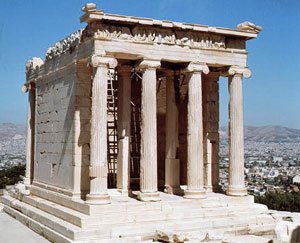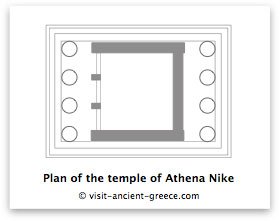Many visitors to the Acropolis almost miss the temple of Athena Nike. It’s easily done.
As you climb the steps to the Propylaea, the grandeur and magnitude of the structure is very impressive and demands all your attention. Today, the steps don’t approach the Propylaia directly as they did in ancient times. For part of your walk you actually have your back to this little temple.
As you reach the last section of steps and begin to enter the Propylaia, turn and look to your right. You’ll see the temple of Athena Nike perched all on its own on a section of projecting rock.
This rock was known as the Nikepyrgos, and in Mycenaean times was used to defend the Acropolis.

Built in honour of Athena
The temple of Athena Nike was added between 432 to 421 BC. The Peloponnesian war between Athens and Sparta was fought between 431 to 404 BC, so the temple was constructed during the war. The great Athenian leader, Pericles, died in 429 BC.
Experts tell us that the style of the temple, judging by the column bases and capitals, was already old fashioned even when it was being built. The columns were in the Ionic style, and there are four at the back and four at the front.
The temple was dedicated to Athena, the bringer of victory (Nike). Perhaps the Athenians hoped that their show of dedication to their goddess would persuade her to help them defeat the Spartans. As the outcome to the war showed, their efforts were in vain.

Why is it in such good condition?
You might wonder why this little temple is so well preserved. During the time when the Turks ruled Greece they incorporated the temple into a defensive bastion. The other parts of the bastion were removed in 1836, leaving the remains of the temple on its own. It was partially rebuilt at that time.
It was rebuilt again in the years from 1936 to 1940, and today is probably the most delicate structure on the Acropolis.
The legend of Theseus
When Theseus returned from Crete and his defeat of the Minotaur, his ship was supposed to hoist white sails if he had succeeded and was alive and well, but black sails if he had been killed. For whatever reason, the ship was displaying black sails. When his father Aegeus looked out and saw the black sails, he thought his son was dead, and in despair threw himself off the spot where the temple was later built.
Aegeus is also reputed to have thrown himself off the cliffs at Sounion. That version has an added attraction. In memory of him the sea in which he perished was named after him – the Aegean sea.